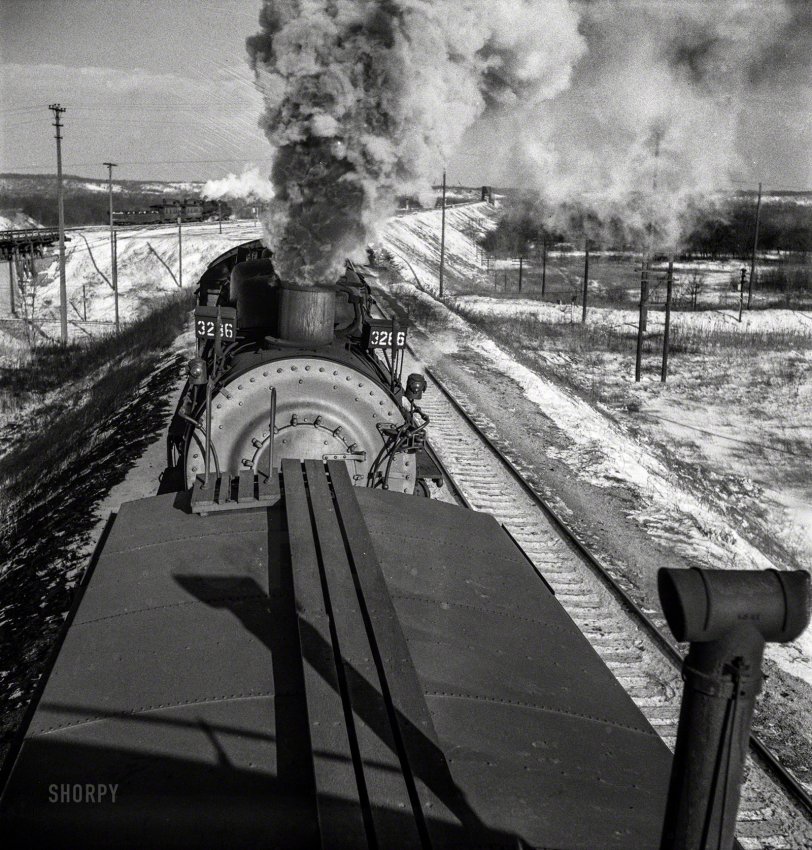


Framed or unframed, desk size to sofa size, printed by us in Arizona and Alabama since 2007. Explore now.
Shorpy is funded by you. Patreon contributors get an ad-free experience.
Learn more.

- Complicated then, forgotten now
- Bryan-Stevenson
- Skinny is as skinny does
- How do you rest in peace
- Riding the footboards
- Alas, hidden from view
- Baldwin Diesels
- Exclusive pump
- Bananas, Oysters and Smokey Joe
- Details, Details
- What's that building to the left of the tower?
- Coal Barges
- Bromo-Seltzer
- Inner harbor
- The Basin
- What a headache!
- Giant stepladder?
- Yeah, it was cold
- Love those coats
- Link & Pin Days Remnant
- Baldwin 62303
- Baldwin VO-1000
- Cold
- No expense spared
- Tough Guys
- What's your hurry, where's your hat?
- Sheriff's Signature
- Relocated in the Eighties
- Lost in Toyland
- And without gloves
Print Emporium
Tailgater: 1943

March 1943. "Chillicothe, Illinois. A helper engine is taken on for added power on a grade extending eight miles on the Atchison, Topeka & Santa Fe between Chillicothe, Illinois, and Fort Madison, Iowa." Medium-format negative by Jack Delano for the Office of War Information. View full size.
Pusher man
After the helper is coupled, there is a simple application/release air test.In preradio days, we'd hold off on the release until we were ready to go. When the air released, the helper would start shoving and the lead engine would start pulling. You'd be amazed how fast a long freight can get up to speed from a standing start with engines on both ends.
The lead engine aways controls the speed. The helper's job is to push.
Coordination?
I wonder how they coordinate power levels, or maybe the lead engine goes all out and the trailing one controls the speed.
Risky Business
Use of helper engines was a common but dangerous practice prior to automated controls. My father, a long-time railroad special agent/claims agent, listed a couple of helper-caused wrecks as two of the worst he had to deal with.
Must Be a Steel Caboose
In earlier times, a wooden caboose was placed behind the pusher. Leaving it between the loco and rest of the train could end badly for the tail end crew.
Helper Engine
#3286 was one of 128 locomotives ordered from the Baldwin Locomotive Works, Philadelphia, Pennsylvania. The locomotives were built between 1917 and 1920, and delivered in batches, with 3286 being the next to last delivered. The Santa Fe was a steady customer of Baldwin-built locomotives over the years. 3286 was a 2-8-2 Mikado Class engine. All of the 128 locomotives of this class were gone by 1955.
Minor Refinement to Location
Great photo! The location is where the Santa Fe (now BNSF) crosses the Rock Island (now IAIS). The train is starting on the climb up the 1% Edelstein Hill.
As a child I spent a lot of time at this exact place watching freights & the Chiefs. (Born too late for stream.) The best visit was a late night Thanksgiving with a gentle snow & 2 caboose back to back with flickering oil lanterns. (Which surprised me since I always thought they were electric.)
Considering the year & month, it is probable my grandfather was clerking at the station & my Dad was working on the bridge in the background over the Illinois River.
























On Shorpy:
Today’s Top 5